I suppose I sort of asked myself this question to conclude Monday’s blog post, and thus I felt the topic was somewhat unfinished.
We are running out of land in Toronto on which to build housing, and developers are buying fully-functional 20-storey office buildings to build 60-storey condominiums!
A lot of the “old” properties in the original Town of York aren’t actually designated heritage, but rather merely listed.
Which of these could we see become condos in the coming years? Let’s take a look, and debate whether or not these buildings are worth saving…
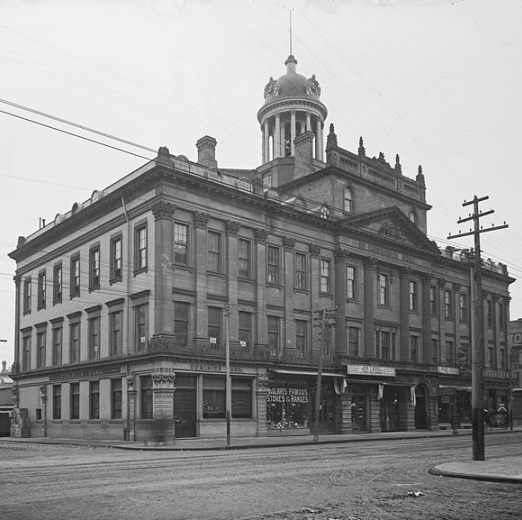
I’ve always been a bit of a history buff.
Although my first real interaction with the subject of history did not go very well…
Leaside High School, at least while I attended in the 1990’s, made a spectacle each and every year of “The History Fair.” I had heard about it in years’ prior through babysitters, and eventually I had witnessed it through my older sister’s display.
History was taught to both Grade-9’s and Grade-10’s, as you had the option of taking Geography or History, in those two years.
I decided as soon as Grade-10 started that I was going to win The History Fair; well, me, and whichever three guys I would be saddled with as a “group.”
My topic was “The History of American Influence On Sports In Canada,” and I was proud of having the most unique topic ever presented.
Every year, the same topics would be covered: Confederation, The War of 1812, Canadian Writers – anything you can think of that involved Canada.
But in 1995, having witnessed what I had with respect to sports in Canada over years prior, I decided this would be our topic.
In hockey, our national past-time and the game we had invented, we had only five of then twenty-six NHL teams based in Canada, and two (Quebec and Winnipeg) had moved to American cities, despite over 85% of the NHL being comprised of Canadian-born players.
In basketball, the inventor of the game, James Naismith, was Canadian, and yet we were never mentioned by journalists, commentators, coaches, or players in the NBA or NCAA, even though Toronto’s Maple Leaf Gardens hosted the first ever Baskeball Association of America (precursor to the NBA) game in 1946. The NBA still credits this November, 1946 event as “the first official game of the NBA.” It took almost fifty years for Canada to get a basketball franchise.
In football, we had never been invited to join the NFL, and our very own Canadian Football League had been invaded by the Shreveport Pirates, Sacramento Gold Miners, Las Vegas Posse, Birmingham Barracudas, the Memphis Mad Dogs in what was an absolute bastardization of our Canadian game during a failed mid-90’s “American expansion.”
And in baseball, the game had been played in Canada since 1838 (which many claim was the first documented game of baseball, anywhere, ever), and was actually adopted from a British game called “rounders” when Canada was a part of Britain, and yet an American named Abner Doubleday was long credited with having invented the game; a claim that has since been proved false. We were also coming off back-to-back World Series wins here in Toronto, which added some fuel to the fire.
Hockey clearly dominated our thesis, but the overall presentation was fantastic.
We cornered off about 50-60 square feet in the corner of the gym, and built a fortress out of the display boards that, in all likelihood, were for all presenters to use, but the guys in my group were big and scary, and stole enough boards to set up what was basically a small “room.”
I did 99% of the work on the project, and my mother, sister, and even my little brother (who was in Grade-8 at a different school!) helped me put the displays together. I’ll never forget, the morning of the History Fair, my brother skipping his breakfast to help glue Bristol-boards together on our kitchen floor before he went off to school.
Our project absolutely crushed it.
It was the talk of the school, and on the “public” night, all the parents were jamming into our makeshift-room. At one point, we had a lineup to get in!
At 15-years-old, this was the proudest I had ever been, of any accomplishment. And the recognition that came with winning “1st Place” would justify the countless hours I put into the project while my three team members were slacking off (one of them called me, drunk, with a group of other people to ask, “Do you want to have a party at your house?” as I was typing up a section of our project on Word Perfect 7.
The day before the winners were set to be announced, my teacher, Mr. Verdun, asked me to stay after class.
I thought he was going to be the first to say “congratulations” to me, but it turns out, it was the complete opposite.
Mr. Verdun told me, “Ordinarily, I would never have this conversation with a student, but I think you might be mature enough to handle this, and plus, I think you deserve an explanation.”
My heart sank.
He told me that The History Fair was completely political, and the winners were pre-determined, based on the years. This year, the winner would be from the French Immersion program, since they rotated years with the English projects. Not only that two of the three – 1st, 2nd, and 3rd “winners,” would be French, and the third would be English, as it had been decided, but, the English winner would be from the other teacher’s class, since Mr. Verdun had two of the top three the year before.
Mr. Verdun told me that nobody from his class had a chance, no matter what they did.
“This is how it works in the real world,” he told me, “So perhaps the silver lining in all of this is that you see how things really work, and how politics plays a role with everything in society.”
I went from being proud of my project, to being completely ashamed.
I was embarrassed to have put all that work into a project, and have nothing to show for it.
I felt like the entire school was laughing at the idiot who spent his nights at the library researching baseball’s origins, when everybody else was smoking pot and having fun.
It’s been twenty-two years, and as you can tell, I’m still bitter. But I learned a valuable lesson that day, one that’s probably more valuable than anything I learned in four years of high school.
So what’s the point to this story?
Well, my intention was to make a mere mention of The History Fair, as a lead-in to a blog about Toronto’s history, but now I’m staring at the word-count and seeing over 1,000, and this has almost become a post of its own.
“You mean you didn’t come to Toronto Realty Blog to read about my high school experiences?”
I guess the take-away was supposed to be about politics, and how so much of the decision-making with regards to the growing landscape of our city is absolutely, positively, political.
Take the decision to allow David Mirvish and Frank Gehry to build eighty-storey condominiums in an area where the largest condos are HALF the size, and on the site of the historical Princess of Wales Theatre.
Tell me that decision is not political.
You’ve got a member of the prestigious Mirvish family, with money and influence, partnering with a world-renowned, Toronto-born architect who is in his final days, looking to make a mark on the city, and even though there is absolutely zero precedent for 90-storey towers (remember they wanted two 90-storey towers, before they “agreed” to scale back to three 80-storey towers), I don’t believe this project was ever in doubt.
So if these guys are allowed to tear down the Princess of Wales Theatre, how come the developer who wanted to tear down the historically designated building at 251 King Street back in 2008 wasn’t allowed?
Politics, that’s why!
Also keep in mind that when it comes to the Toronto Heritage Register, there are properties that are merely “listed,” and then there are those that are “designated” as heritage properties, and with that, comes restrictions on what can be done with them. Just ask the residents of areas like Rosedale, where virtually every home has significant hurdles to development and renovation.
So while I can already feel this blog is going to be way too long, I thought today I’d look at some of the more notable older buildings in the St. Lawrence Market area, and discuss why they’re significant (in addition to giving you a brief history lesson that you didn’t ask for), whether or not they’re listed or designated, how large the sites are, and whether or not I think they could be redeveloped.
You may recognize these buildings as having walked by them many times, so if you’re learning some history by reading this, then I’m quite pleased!
Bank of Commerce – 1907
144 King Street East
Heritage Status: Listed
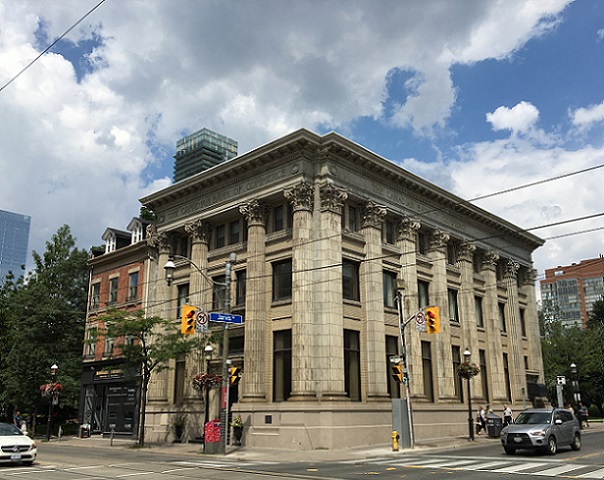
This was an original branch of the Canadian Imperial Bank of Commerce (CIBC), but more importantly, this is where the Township of York held it’s council meetings for forty-three years.
While the main floor of the building was used for the CIBC branch, the second and third floors contained offices which were the perfect meeting place for the city council, and thus it became the York Council Chambers beginning in 1907.
Council members had previously met across the street at St. Lawrence Hall before the current structure was even built in 1850, and dating back as far as the early 1800’s.
This city block at Jarvis/King and down to Front Street was home to several different City Council meeting places, in several different buildings for more than a century due to the constant rebuilding of the structures and of course the great fire of 1849.
The adjacent building on the west side – that red-brick, 3-storey structure you can see in the photo, was built in 1850 and is also merely “listed” as heritage.
Together, the two buildings sit on a 7,087 square foot piece of land.
I would hate to see either building demolished, or even built upon. But a developer must be salivating at the idea of those north and west-facing park views overlooking St. James Cathedral.
–
Daniel Brooke Building – 1833
150 King Street East
Heritage Status: Listed
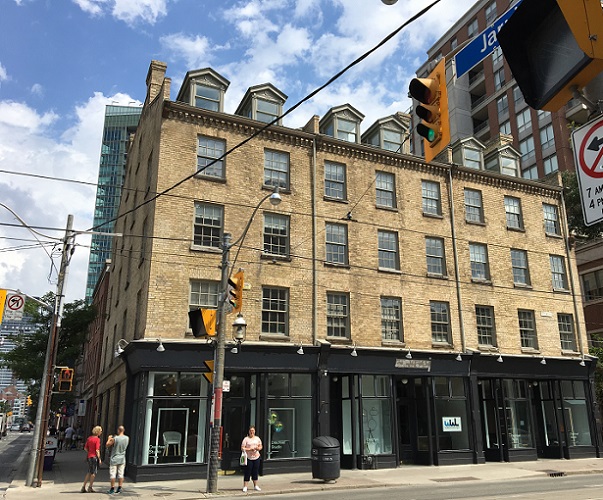
This is one of the oldest buildings in the old Town of York, and unlike the former “Grand Central Hotel,” which was incorporated into the King Plus Condos development in 2016, the Daniel Brooke Building still stands on its own, as originally constructed.
The most amazing part about this building, as I wrote on Monday, is that The Great Fire of 1849 wiped out a large portion of the Town of York, and yet this building remained. The fire started right next door too, and somehow, magically, this building was left unscathed.
The building’s name is merely derived from the person who owned the land and had the building constructed in 1833, Daniel Brooke, who would otherwise have disappeared from history.
Notable tenants include The Patriot newspaper in the mid-1800’s, which as you might assume from the name, had some right-wing undertones to say the least. “The Patriot” logo is still visible on the building today, if you look above the second floor window on the east-most side of the building.
This property is designated heritage (along with 61-63 Jarvis), and the site measures 4,356 square feet.
As much as I would like to think this lot is too small on which to build a condo, the condo would be too close to 168 King Street (and block views), and this building has massive cultural and historical significance, I suppose anything is possible…
–
Toronto Street Railway Stables – 1887
165 Front Street East
Heritage Status: Designated
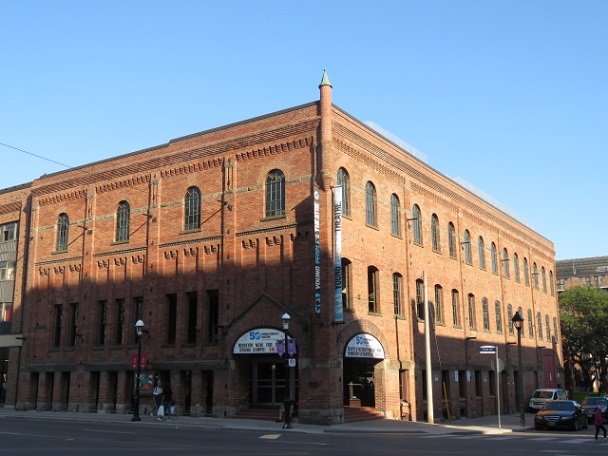
On September 11th, 1861, the very first street railway line opened in Toronto and ran a route from Yorkville Town Hall down to St. Lawrence Market. The goal was to complement the very successful Williams Omnibus Bus Line which was the first mass transportation system in Toronto, running four buses each capable of carrying six people.
The Williams Line became far too busy to meet the growing demand, and thus the City of Toronto issued a transit franchise for a street railway
The three-storey brick building at 165 Front Street East was built as a stable for the horses that pulled the Toronto Street Railways horse-cars, and later served as electrical generating plant before becoming a warehouse for the Toronto Transit Commission in the company’s infancy.
In 1966, the building was converted to Young People’s Theatre.
The site measures 10,201 square feet, which is big for a downtown site, but the property is designated heritage, so maybe developers will just have to go back to looking at parking lots…
–
W.A. Drummond & Company Dairy Supply Warehouse – 1911
204-214 King Street East:
Heritage Status: Intention
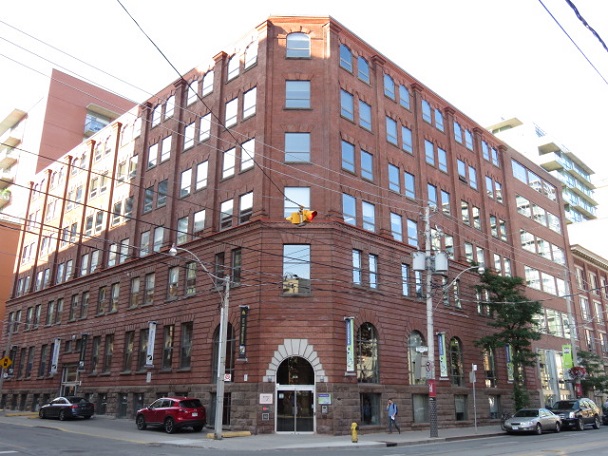
Heritage Toronto has placed a plaque on the side of the building that says “Adams Brothers Harness Manufacturing Company, 1903,” but the property is listed in the Toronto Heritage Register as being home to the W.A. Drummond & Company Dairy Supply Warehouse, dated 1911. I’m assuming the former pre-dated the latter!
But if you really want to delve back in time, consider that before the current structure was erected, this was the site of the very first brick home in the Town of York.
Constructed between 1807 and 1811, by a man named Laurent Quetton St. George, whose purpose in building the first brick house in York, a town of 700 people was to impress the parents of a young lady he was courting, to try and win her hand in marriage.
It didn’t work…
The house was torn down a near century later in 1904, and the 7-storey red brick structure that stands today, was built.
This site measures 30,784 square feet, which is 0.7 acres, and that’s massive for downtown!
It sold for over $30,000,000 back in 2008, so we can only guess on what this would sell for now.
City council recommended the building for heritage designation in 1985, and an easement agreement was reached in 2011, but it still remains as “intention” by definition, and thus is not designated.
The site includes the adjacent buildings at 185 Frederick Street and 214 King Street, so I believe there are already enough tenants in these buildings to provide an exceptional return. I don’t see this building being included in a condominium development any time soon.
–
Bank of Upper Canada – 1825
252 Adelaide Street East
Heritage Status: Designated
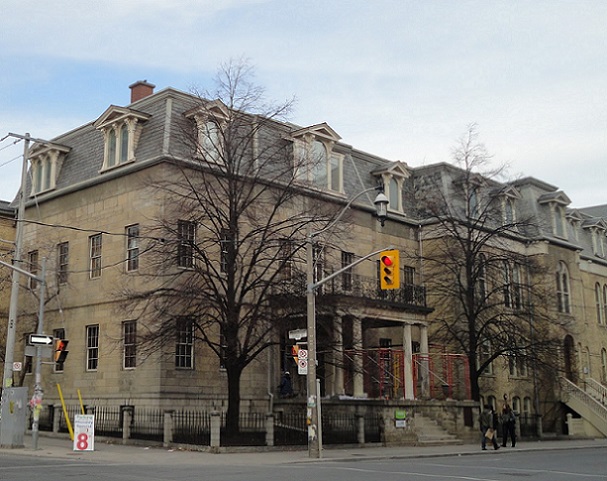
In 1822, there were only 2,000 residents of the Town of York, and thus there was no bank in the town. Residents who needed to borrow money (I suppose there were no bank accounts at that time, and people stuffed their money in their straw mattresses?) had to travel to other cities such as Montreal, which was the capital of Canada at the time, and the financial hub.
The Bank of Upper Canada opened in July of 1822, and was constructed entirely of white stone blocks. It continued to function for 48 years as other rival banks started to pop up throughout the town.
In 1870, the De La Salle Institute purchased the building from the bank, and opened a Roman Catholic college for boys. They also purchased the building next door to the east, which is a red-brick building that served as the first post office in Canada.
There were other tenants over the years, but the building was completely empty by the 1960’s, and like many of the other buildings in the St. Lawrence Market area, it sat boarded up, and decaying.
It was designated as heritage in 1978.
“Post House Condos” was built at 105 George Street, behind the Bank of Upper Canada, and Toronto’s Post Office, so along with the fact that these buildings are heritage, I see zero redevelopment possibilities, at any point.
–
These are only five of the many heritage-listed and heritage-designed buildings in the St. Lawrence Market area, and of course, the SLM area is not the only neighbourhood in Toronto that houses the city’s history.
As a reader pointed out on Monday’s blog, there are some heritage-designated buildings that seem to be sitting and rotting, with no end-game, and no visible value in terms of cultural or historical significance.
But then there are some gorgeous buildings, that I personally think are worth preserving.
And buildings like St. Lawrence Hall, which is the black-and-white feature image of this blog, need not even be discussed in this manner, since it should remain in its entirety, and never be demolished or built upon.
But that’s just my opinion. Let me know if you disagree…



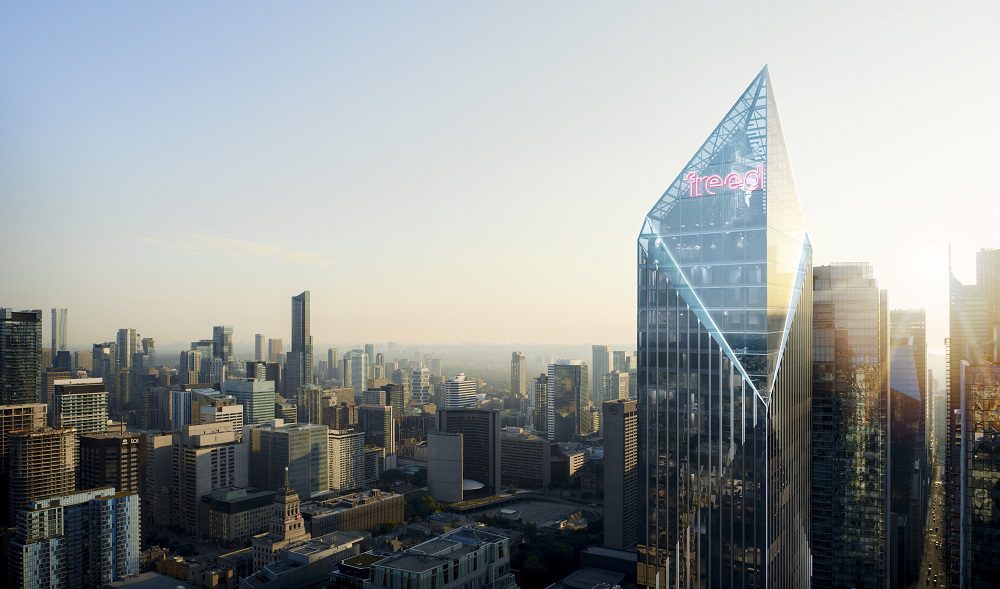



























Doxo
at 11:54 am
Cool story Hansel!
Jack
at 2:09 pm
The examples shown are all on corners. Corner buildings are especially critical, because they are more visible and because we get more benefits from the empty space above them (lines of sight, sunlight). So if we (i.e. our city representatives) have to choose our battles, let’s preserve the corner buildings.
More generally, sometimes it is possible for the new highrise to be built not on top or inside a heritage building but behind it in the adjacent unused space set off from the street. That imho is the preferred way. That of course means that the developer has to accept a smaller footprint.
And another point: I don’t see the need to mess with historical building in the inner core as long as there are long blocks of ugly two-story houses of no particular significance on main avenues just a few stops away on the subway or the street car. The priority should be to tear those down and replace them with midrise condominiums and rentals.
But all that, as David points out, comes back to politics, i.e. who calls the shots.
Ralph Cramdown
at 12:21 pm
Political? If you could pick anywhere in the city as ideally suited for three 80 storey condo towers, wouldn’t you choose somewhere that’s walking distance from the central business district, subway, Union Station and the train to the airport? Maybe somewhere with a perfect walk score of 100?
There’s a BIG group of people who say that Toronto is a “World City” and should expect 100k+ immigrants every year forever, but when a project like this gets proposed, folks reach for the smelling salts. Same people in both groups? News flash: Toronto isn’t “running out of land on which to build housing.” Ranked by population density, Toronto is pretty low among cities around the globe. If we doubled our density, we’d only move half way toward the top. Similar to what Jack says below, drive along most any major thoroughfare and pass mile after mile of two and three storey mixed use crap.
— Greetings from the Best Place on Earth, where even the driving school cars are Mercedes
JCM
at 1:30 am
Do you find it interesting that this blog — at one time a breathless voice predicting the next all-time high for TREB average prices and then hyping it when it arrived — has been reduced to these sorts of “human interest” posts? Hmmmmm…
Sarah
at 3:43 pm
These ‘human interest posts’ its what has me read this blog. Don’t go throwing statistics and values at me – I won’t read it, and truthfully I see enough of it day-to-day at my own job.
As someone who works in RE, I appreciate reading stuff like this because I can relate/ form an opinion based on my personal industry knowledge without having to open an excel file and analyzing numbers.
David does an amazing job appealing to all audiences!!
TJ
at 8:43 am
Great post!
T
at 4:02 am
All trash except the bank buildings.
You could knock them all down.
Just old garbage labelled as historic because of age, not architectural value.